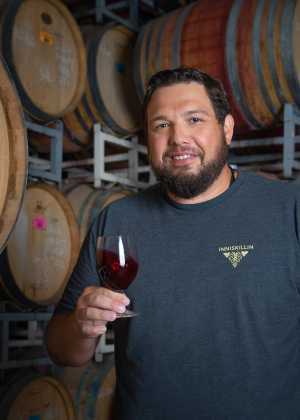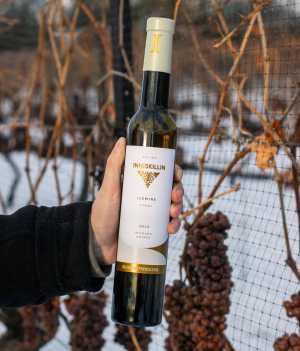Months after the fall harvest takes place in Niagara, there’s another round of grapes that are handpicked from the vines. When the mercury drops, winemakers are out in the cold picking frozen grapes that will later become icewine, one of Canada’s most iconic products — and, arguably, its most misunderstood.

Nicholas Gizuk, winemaker at Inniskillin Niagara
The sweet wines, with complex fruit flavours, are much more versatile than we’ve been led to believe. Go beyond dessert pairings and try icewine with spicy dishes or gooey cheese and charcuterie. However you drink it, the highly concentrated, high-risk Canadian wine is something to be appreciated and enjoyed.
We chat with Nicholas Gizuk, winemaker at Inniskillin Niagara Estates Wines, to find out what makes Canadian icewine so special and why we ought to be savouring the sweet wine this season and beyond.
What is icewine?
"It's this rare, luxurious wine made from grapes that we leave out to freeze on the vine in our beautiful Canadian winter. The freezing aspect actually freezes the crystalline structure of water in the grapes. Then we press off this flavour with an exquisite sweetness, complexity and beautiful acid tones that make it very rich. It’s Canadian heritage.
"When you think of things that really define Canada, you think about maple syrup and hockey. In those top categories, I would put icewine. It's a truly unique, iconic Canadian product.”

What’s the history of icewine?
“The early stories in 1700s Germany are really the origin of eiswein. The monks would go on a pilgrimage and make wine and mead. They left, then came back, and everything had frozen on the vines. Instead of walking away from the harvest, they tried to process it and make wine out of it. That's legitimately the first icewine. The modern era in Canada began with Hainle [Vineyards Estate Winery] in B.C. right at the beginning of the 1980s. They made the first icewine. It wasn't a commercial product; they just did it as a test.
"In Niagara, the first year was 1983. Andrew Peller, [Dr. Joseph Pohorly from] Hillebrand, Karl Kaiser from Inniskillin and Ewald Reif — German, Hungarian and Austrian descent winemakers — agreed to leave grapes out on the vine. Unfortunately, Karl [Kaiser] and Mr. Reif didn’t net their grapes, so the birds ate them all, but Peller and Hillebrand were commercially the first to make a bit of production. Our first vintage here at Inniskillin was in 1984. Kaiser took an icewine to Toronto in 1984, and it was the first icewine to win a Canadian medal. What really put us on the map was winning the Grand Prix d'Honneur in 1991 for Karl's 1989 Vidal Icewine."
It wasn't just a win at the 1991 Grand Prix in Vinexpo in Bordeaux, France. The award cemented Canada's global stature, pitting them head- to-head with the Europeans and emerging triumphant. "Everybody thought Canadians lived in igloos, and now they’re making wine? That really set the stage for the evolution of the Canadian wine industry at the time.”

When is icewine made?
“A great wine-growing season is also great for icewine. Typically, our growing season starts in April or May when we get a bud break, and grapes grow all summer. The icewine harvest can happen as early as November here and as late as the end of March. That's about a five-month window where we're waiting for Mother Nature to say, ‘Hey, you're ready to pick icewine.’”
How is it made?
“Here in Canada, icewine is regulated by the VQA. The regulation in Ontario states that it needs to be at least -8 C. You have to register all the blocks you will make icewine in. We separate that beautiful nectar and leave water behind. We press it at -8 C because we’re looking for a window of about 38–42 degrees Brix.” Degrees Brix is a unit of measure to determine the amount of dissolved solids in a liquid — in this case, sugar content and juice.
“Once you're done pressing and have all of your juice in the tank, the minimum for icewine VQA regulation is 35 Brix.” Anything with insufficient Brix cannot be made into icewine and is often sold as a special late harvest or select late harvest.
“We like fermentation to be at a warm temperature. However, we generally make icewine in January or February. It’s a lot of work to keep the juice warm and make the yeast happy. Once we get fermentation through, we’ll filter, and then it goes into a bottle over a period of about a year — we don’t bottle everything right out of the gate. Inniskillin supports about 95 different SKUs of icewine from 50 ml to 375 ml, across an array of different varietals.”
Why is icewine so special?
“These wines have another level of complexity. Generally, because of our winters, there's very little rot, and very little Botrytis affecting the grapes because they freeze and fall off. We have these beautiful, hard solid berries. So when I'm making icewine, you're getting beautiful 100 per cent concentrated riesling, or vidal or cabernet franc. I call this purity of fruit; there's no more concentrated version.”
Which grape varieties are used?
“Vidal blanc, the hybrid grape, is about 80 per cent of our production. We also carry riesling and cabernet franc as our core varieties. Some years, I do some cabernet sauvignon icewine, and I’ve done some chardonnay — we always play around with different varieties. I generally don't mix varietals …. because I really like to understand different varieties grown in different locations and how they taste.”
Does icewine have a high alcohol content?
“That’s actually a misconstrued concept. The alcohol is only 9.5 per cent. My style is about balance. It’s nice because you’re drinking a half-litre of wine, so you’re actually getting less alcohol.”
Why is it so expensive?
“It’s a lot of work to make this beautiful product. We could pick vidal in September–October, make table wine and have that product on the shelf by December or January. Whereas [with icewine], we're risking Mother Nature by leaving grapes on the vine. It could rain, it could mould, it could rot. Raccoons could eat them, deer could eat them or the wind could blow them away. So there's lots of risk when it comes to icewine, but that's part of the game.”

How does the terroir play into things?
“We are ideally suited in this area. Our huge advantage is that we have the Niagara Escarpment, the river running down from Niagara Falls and Lake Ontario — a big, beautiful body of water that doesn’t freeze. That really moderates the temperature.
"[We have] hot, sunny days; the sun goes down, the cool air rises, hits the escarpment and cools our grape vines down. Instead of generating sugar at night, they kind of go to sleep for about three or four hours. It allows us to retain a lot of beautiful natural acidity in our grapes and allows us to get what we call off-odour compounds — because nobody wants to drink what is essentially sweet water if you don't have any of these beautiful flavours.
“Niagara is probably the only place that hasn't missed a vintage for icewine. Other regions like Germany and Austria have missed quite a few [vintages] in the last few years because it didn't get cold enough. We didn't invent it, but Canada has perfected it.”
The patio at Inniskillin Niagara
What are some great icewine pairing options?
“We do a series called Inniskillin Obsession Wins Dinners. With these three- to five-course dinners, we pair a table wine, which people expect. But I also pair icewine alongside the whole meal so people understand that you can put our beautiful cabernet franc icewine with an arugula salad with strawberries and goat cheese. It brings out the richness of the strawberry flavours, and the natural acidity in the wines makes them excellent paired with cheese.
"Because icewine has a natural PA, [potential alcohol content], of about 10 per cent (which is similar to French champagne) it makes pairing with dishes very easy — especially spicy dishes, Thai food and Chinese food like dumplings. If you have a weak wine paired with that, you lose all of the pairing capability. So you need a rich, strong, concentrated wine to stand up to dishes like this.”
